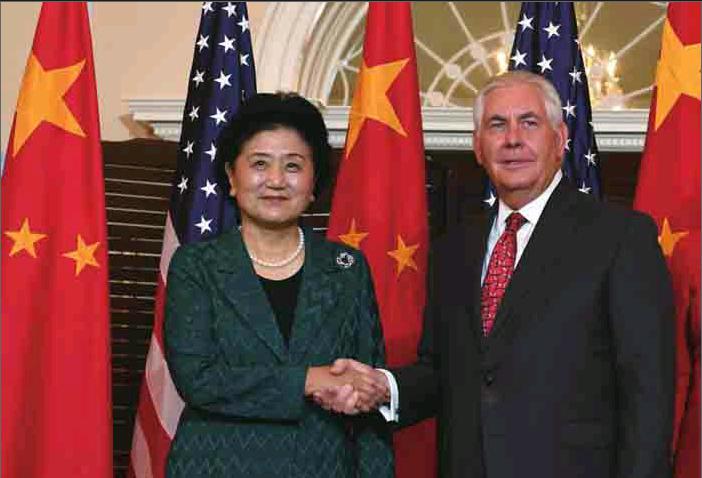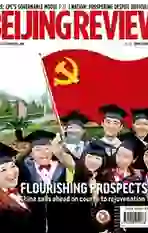A Bridge to Friendship
2017-11-06ByDuLan
By+Du+Lan

The first China-U.S. Social and Peopleto-People Dialogue, co-chaired by Chinese Vice Premier Liu Yandong and U.S. Secretary of State Rex Tillerson, was successfully held in Washington, D.C. on September 28. With the theme of “ living together for the next 50 years based on mutual understanding,” this dialogue provides a platform for China and the U.S. to exchange views on bilateral ties and cultural communication. At the dialogue, the two sides reached important consensus and issued the China-U.S. Social and Cultural Dialogue Action Plan.
A fruitful dialogue
The action plan focuses on improved cooperation in seven areas: education, social development, science and technology, health, culture, local exchanges and environmental conservation, detailing over 130 projects for the two sides to implement.
According to the action plan, concerted efforts will continue to be made to improve mutual exchanges in education including student exchanges, establishing institutional cooperation between universities and think tanks, and promoting communication on innovation and entrepreneurship between teenagers.
As for social development, cooperation on gender equality and women empowerment will be strengthened, and exchanges in sports will be improved. Meanwhile, both sides have stressed the vital role of teenagers in people-to-people exchanges.
China and the U.S. will strive for more cooperation on environmental protection and enhance support for air pollution control, water conservation, solid waste management and soil contamination prevention.
In science and technology, the two nations have agreed to enhance mutual communication by renewing the China-U.S. Agreement on Cooperation in Science and Technology and implementing personnel exchange projects.
The Sino-U.S. Cultural Forum was held in New York on September 26 as a move to enhance cultural exchanges. Besides, the two sides have agreed to achieve more communication between libraries, museums and other public culture and arts organizations.
Meanwhile, cooperation in these areas will also be conducted between Chinese provinces and U.S. states, as well as between cities in the two countries.
Fever for Chinese and U.S. culture sprouted even before this dialogue, as a series of cultural exchanges were held from September 25 to 28, including the China-U.S. Young Maker Competition, the Sino-U.S. Cultural Forum, the China-U.S. InnovationDriven Development Forum, and the China-U.S. Workshop on Health Cooperation.endprint
One of four dialogues
Four cabinet-level dialogues were set up during the first meeting of President Xi Jinping and President Donald Trump this April. Among them, the diplomatic and security dialogue and the comprehensive economic dialogue were held in June and July respectively, followed by the law enforcement and cybersecurity dialogue and the social and people-to-people dialogue in September.
The four newly established high-level dialogue mechanisms, compared with the two dialogues under Barack Obamas presidency(Strategic and Economic Dialogue and HighLevel Consultation on People-to-People Exchanges), have expanded the ranges of communication and are expected to bring more pragmatic results for the two nations.
Based on the high-level consultation about people-to-people exchanges, the social and people-to-people dialogue highlights the important role of social and cultural communication in promoting bilateral ties. During Obamas visit to China in November 2009, the two governments agreed to set up a fresh consulting mechanism to enhance cultural understanding between the peoples of the two nations. The fi rst round of HighLevel Consultation on People-to-People Exchanges was held on the sidelines of the second Strategic and Economic Dialogue in May 2010. From 2010 to 2016, seven rounds of the consultation were held, in which hundreds of projects were agreed and implemented in areas such as education, science and technology, culture and sports.
Vital significance
This year marks the 45th anniversary of the release of the China-U.S. Shanghai Communiqué. After four decades of development, Sino-U.S. ties have evolved as the most important bilateral relations in the world, as Chinas influence has greatly increased with its booming economy. The way in which the two nations interact with each other and the U.S. attitude toward Chinas progress are not only critical to the two countries development, but also play a decisive role in international relations as a whole in the 21st century.
However, healthy Sino-U.S. ties are challenged by the lack of strategic mutual trust, structural contradictions and the risk of the so-called Thucydides trap, that a rising power is predestined to come into conflict with a ruling one. Trumps coming to power also added uncertainty to U.S. diplomatic policy and Sino-U.S. relations.
Despite of all these challenges, maintaining stable and friendly cooperative relations over the long term still remains the goal of both governments policies, and positive progress has been achieved with their efforts.endprint
Xi and Trump have met twice this year, in Florida in April and in Hamburg after the G20 Summit in July, and had seven phone calls. The two presidents are maintaining unimpeded communication on major issues.
The four high-level dialogues provide more platforms for effective communication and enhanced mutual understanding between the two governments.
On the sidelines of the China-U.S. Social and People-to-People Dialogue, Liu met Trump and conveyed Xis greetings to him. After the dialogue, Tillerson paid a second visit to Beijing to pave the way for Trumps fi rst state visit to China in November.
Social and people-to-people exchanges have served as a booster and lubricant to promote Sino-U.S. relations. Through years of exchanges and communication, mutual understanding and trust have increased, winning public support for long-term stable and healthy bilateral ties.
As the area where China and the U.S.“have the least disagreements and the most consensus,” the High-Level Consultation on People-to-People Exchanges yielded many fruits in the past seven years which have greatly contributed to better China-U.S. relations.
Currently, bilateral structural contradictions between China and the U.S. are prominent, represented by increasing divergence on regional and global issues, which also lead to different voices inside the U.S. In this context, enhancing people-to-people exchanges is more imperative and necessary.
Long way ahead
Since the start of the China-U.S. people-topeople exchange mechanism in 2009, the two countries have had unprecedentedly deep and wide-ranging communication in the areas of society, education, culture and science and technology. In 2016, more than 5.3 million people traveled between China and the U.S., an increase of 1 million from 2014. And now, a total of over 10,000 citizens of both nations shuttle across the Pacifi c each day.
From 2010 to 2014, over 100,000 U.S. students studied in China with the support of the 100,000-Strong Initiative of the Obama administration. Among the foreign students studying in the U.S., one of every three comes from China. With the largest number of Confucius Institutes (100) and Confucius Classrooms (356) of any nation, the U.S. has 200,000 students registered at these organizations.
There are 48 sister province/state relationships and over 200 sister city relations between China and the U.S. Meanwhile, more non-governmental organizations (NGOs) and universities also have engaged in bilateral communication and acted as emissaries of cultural exchange. Social and people-to-people exchanges, diplomacy and security, and economic and trade cooperation have become three pillars of China-U.S. relations.
In the future, more NGOs and grassroots groups should be encouraged and absorbed into the dialogue. And, the two nations should focus more on enhancing mutual understanding.
With mutual efforts, social and peopleto-people exchanges will become a bridge of friendship across the Pacific Ocean and gain public support for better China-U.S. relations.endprint
